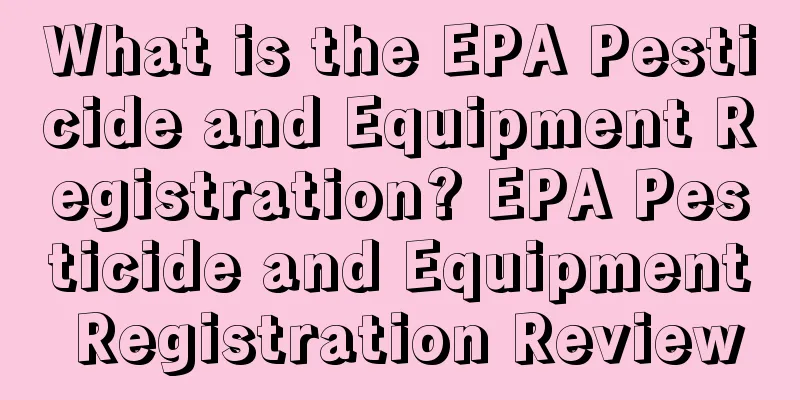What is the EPA Pesticide and Equipment Registration? EPA Pesticide and Equipment Registration Review

|
The Environmental Protection Agency (EPA) is a functional department of the U.S. government, mainly responsible for environmental protection, including the protection of air quality, water, soil, animals and plants. The use of insecticides, antibacterials, pesticides and other products will inevitably have an impact on the environment (including water, soil, animals and plants, etc.). In order to reduce harm to the environment, the EPA has formulated the FIFRA Act (The Federal Insecticide, Fungicide and Rodenticide Act) to manage such products. The executive agency for pesticide products is the EPA's OPP (Office of Pesticide Program). Category Compliance OPP control scope: 1. Devices: Products without chemically active ingredients that kill and repel pests through physical means, such as mosquito killers, mosquito repellent lamps, water purifiers, ultrasonic mouse repellers, various disinfectors, and sterilizers 2. Non-device type: kills and inhibits pests and fungi through chemical substances, generally divided into traditional chemical pesticides, biological pesticides and antibacterial agents. l Traditional chemical pesticides: active ingredients are generally produced in synthetic form, or synthetic chemicals, mainly used to prevent, reduce, eliminate or repel pests; or plant growth regulators, desiccants, defoliants or nitrogen stabilizers. l Biopesticides: Certain types of pesticides extracted from natural materials can be called biopesticides, such as substances extracted from animals, plants, bacteria and certain minerals. Biopesticides are generally divided into three categories: biochemical, microbial, and plant-incorporated protective agents (PIP). l Antimicrobial pesticides: Claims to control microorganisms that threaten human health, including but not limited to microorganisms that are infectious to humans in an inanimate environment. Such as disinfectants, sterilizers, fungicides, and microbial water purifiers. For products with labels claiming to control microorganisms of economic or aesthetic significance, where the presence of microorganisms does not usually cause human infection or disease, EPA classifies such products as non-public health antimicrobial products. Registration Process: l According to the FIFRA Act, companies that distribute and sell products in the United States need to apply for a Company No., and factories that produce and repack need to apply for an Establishment No. The company needs to be associated with at least one Est. No. and complete EPA registration, including annual reports. For non-device pesticides, such products also need to apply for EPA's Register No. If the product contains a new active substance, the active substance also needs to complete the corresponding registration, and the corresponding research report and test data need to be submitted. For active substances that have already been registered, the applicant can cite the data of other companies to complete the product registration when applying. |
<<: What is Zoodel? Zoodel Review
>>: What is Chewy? Chewy Review
Recommend
What is a Business report? Business report review
Business report is a store data statistics automat...
Walmart's California warehouse announced layoffs, and the total number of e-commerce layoffs will exceed 3,000
It is learned that on April 14, according to Retai...
What is POCO? POCO Review
POCO is China's leading and fashionable photo ...
Amazon's major update: Coupon display and rating star changes
Recently, the front-end display of the Amazon pla...
What is Zalando? Zalando Review
Zalando is a large online e-commerce mall headquar...
Amazon US FBA policy update! Allowing more products to create shipments and enter the warehouse!
Amazon US FBA now allows more products to create s...
PPC Advertising Data Report Interpretation
After doing Amazon advertising, you must analyze t...
I just lost my job and only have 500,000 yuan. Is it feasible to find spot goods from 1688? Is it worth investing in private model products? The goal is to survive in Amazon first...
Anonymous user My C position The development of e-...
A large number of sellers’ orders have been cut in half. Has Amazon’s advertising rules changed?
MarketPlace Pulse data shows that in 2022, Amazon ...
Trump 2.0 is launched. What impact will the cross-border e-commerce industry have?
At noon on the 20th, Eastern Time, Trump was swor...
The US apparel market will cool down in Q4! Which categories can turn things around?
According to research by NPD Group, consumer conce...
USPS orders 50,000 delivery vehicles to increase cargo capacity! 10,019 delivery routes have been confirmed!
It is learned that USPS announced an order for 50,...
The epidemic prevention material controversy reappears! The United States seized more than 3,000 counterfeit vaccine cards shipped from China!
▲ Video account attention: cross-border navigation...
The latest Amazon news for sellers
The Amazon market is unpredictable and unpredictab...
What is Sellozo? Sellozo Review
Sellozo is an Amazon seller advertising optimizati...









